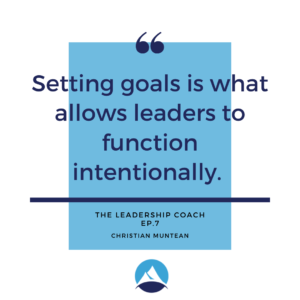How to Break a Destructive Habit

 In this article, I explore how some habits hold leaders back from higher-level success. I introduce a simple process for creating new, healthy habits.
In this article, I explore how some habits hold leaders back from higher-level success. I introduce a simple process for creating new, healthy habits.
I coach successful, effective leaders. They are smart, competent, and motivated. Most have already made significant accomplishments. Yet, there is nearly always an unhelpful habit that is frustrating them and holding them back in some way.
Most of the time, they aren’t aware of this habit. Or they don’t recognize that the habit is what is holding them back. They only recognize that they have this great vision, but something seems to be anchoring them from moving forward.
Most of these leaders are disciplined people. In fact, high achievers tend to be disciplined. So, they are often surprised to discover that they have a habitual behavior or attitude that isn’t serving them well. In fact, they often believe that their success may even be dependent on this unhelpful habit.
How Successful People Can Still Have Limiting and Unhelpful Habits
There are two explanations for how successful people have bad habits:
- What got you here won’t get you there: A classic example of this is any professional who came up through an industry that relies on hourly billing. This approach to billing develops a strong work ethic, that time = money. The more time you work, the more hours you bill, the more you make. It’s often the approach that drives the early success of many businesses.
However, this habit becomes unhelpful when the leader begins to experience diminishing returns. Even though they or their staff are working even more and even harder – they are getting decreased results. Or, spending more time at the office may cause the loss of what they are supposedly working for (their marriage, family, quality of life, etc.).
Whatever the habit is, these leaders often accurately recognize that is what drove their initial success. So they inaccurately conclude that it is necessary for continued success. The habit may have served them well once, but no longer does.
- Dragons are cute. When they are babies. There is an old story about a child who finds a baby dragon and decides to keep it as a pet. He was told that dragons were dangerous and couldn’t be trusted. But this dragon was so cute and playful, he wasn’t worried. Besides, he could train the dragon to be tame. You may remember the end of the story. The boy and the dragon grow up together. And the dragon, being a dragon, eventually burned down the boy’s house and village. Some habits take time to “mature” and become truly life-impacting. Others need a certain environment or set of conditions. This is true for good habits and bad.
Many leaders have negative habits that, when small, don’t seem that important. It’s just “their way” of handling things. Or a minor indulgence. But when these behaviors grow, they become unmanageable.
What Kinds of Bad Habits Do Leaders Tend to Have?
There are many different kinds of unhelpful habits. They can include:
- Avoiding conflict or difficult conversations
- Perfectionism
- Getting too “in-the-weeds” or hands-on
- Not letting go of authority
- Controlling information
- Self-medication – any behavior designed to numb feelings of discomfort
- Taking or withholding credit
- Being the smartest person in the room
- Consolidating power
- Speaking without listening
- Confusing long work with productive or effective work
In fact, any habit that is now holding you back (even if it was once useful) is now an unhelpful habit.
Why Change?
Athletes, especially new athletes, often develop poor habits early on. These poor habits don’t usually matter that much because the impact they have on performance seems slight. So, they are often not noticed or, if noticed, not prioritized and corrected. However, as they grow, the intensity of their efforts increase. Whether this is moving faster, or with more complexity or lifting something heavier – there becomes increasingly less room for error to achieve “next level” results.
Successful leaders have often been able to manage or ignore unhelpful habits for a long time without a meaningful negative impact. This creates a false sense of security or even dependence on the habit. But at a certain point, to get to the next level will require facing these habits. To drive and sustain that change, you really need to be able to answer these questions for yourself:
What is the “next level” for me?
How important is it to me to get there?
Who is depending on me to be able to be that “next level” leader?
What is at risk if I don’t get there?
Why does my change matter?
How To Change Habits
Habit change is not easy. It takes effort, feels uncomfortable, and there may be many false starts. However, it is also possible. And it is worth it.
Habits are formed according to a pattern. There is a trigger that causes us to exercise a certain behavior that accomplishes some kind of reward (or desired result). It looks like this:
Trigger > Behavior > Reward
Starting from the end:
Rewards: In most cases, the reward we want is good. It typically shakes out to fit into one of three categories. We want to feel significant, secure or satisfied. Those are good desires. There is nothing wrong with those desires. The problems come about in how we go about satisfying those desires.
Behaviors: These are the bad habits. I’ve described some above.
Triggers: These are the events or conditions that challenge or threaten our sense of significance, security, or satisfaction. The way this works is, we are triggered by something, then we go to a behavior (which has demonstrated that it worked in the past) which will give us the reward.
The problem with bad habits is that, somewhere along the way, there is also a negative impact. Often one that works against the rewards we ultimately want. Also, others are often negatively impacted.
The Solution
Habit change isn’t easy. But it also isn’t complicated. Essentially, it isn’t enough to say, “I won’t do that again.” Because the triggers happen and can’t always be controlled. Because the rewards or desires are real things and shouldn’t be ignored. But how we respond can change.
For example, if I tend to make snap decisions that I later regret: The trigger might be a crisis, a request, or an opportunity. The reward might be the immediate sense of peace I gain from resolving a question. But the behavior of snap decisions might lead to the wrong answer and create other problems.
We change our behaviors or our habits by:
- Acknowledging what we ultimately want (significance, security, satisfaction)
- Accepting that triggers exist, can be very powerful, and that we need to respond to them
- Changing the unhelpful behavior for a helpful behavior
In the situation above, I focus on identifying a helpful or healthy behavior to replace the unhelpful one of making snap decisions.
Let’s say that I’m able to achieve a similar level of peace and calmness just by taking ten slow, deep breaths. We know this practice tends to slow the heart rate down, to lower blood pressure, and restore a sense of peace.
By changing the behavior of snap decisions for the behavior of taking ten deep breaths before making a decision, we begin to change our habits, which changes our results.
It really is that simple. But, again, it isn’t always easy. So, I recommend being transparent about your effort at habit change and creating some kind of accountability. This can be achieved within a team. But it is often helpful to have a mentor, counselor, or coach to talk to.
If you want to achieve different results in 2020, you need different habits.
You can do it. Be intentional. Get the help you need.
Take good care,
Christian
Would you like my help for yourself, your team or board to get a clear vision of 2020? Don’t leave it to chance. Give me a call 907-522-7200 or e-mail me.
FREE TOOL: The Value Builder System
Are you curious about the value of your company? The Value Builder System™ is a 13-minute online questionnaire that evaluates your business on the eight factors that contribute more to its attractiveness and value. These factors are scored on a scale of 1-100. Businesses that score over 80 are likely to command 70%-100% higher value than others. Click here to learn more or get your free Value Builder Score.
 I have a new podcast, THE LEADERSHIP COACH, where we explore effective, high impact and enjoyable leadership. We talk about personal development and the attributes that all effective leaders possess. I interview other leadership experts who share their knowledge and tips to help you build the confidence to lead and learn the habits of good decision-making. Episode #7 is available now.
I have a new podcast, THE LEADERSHIP COACH, where we explore effective, high impact and enjoyable leadership. We talk about personal development and the attributes that all effective leaders possess. I interview other leadership experts who share their knowledge and tips to help you build the confidence to lead and learn the habits of good decision-making. Episode #7 is available now.
Opportunities
Did someone send you this article? You can receive it, free, directly from me each week. Click here to sign up. You can unsubscribe at any time. I won’t feel too hurt.
Free Resource: How To Accomplish More Without Doing More is a workbook I created to walk leaders through a process of helping you own your calendar, liberate your time, and still get more done. Download it for free!
Executive and Leadership Coaching: Do you feel overwhelmed? Are you not getting the results you expect from the effort you are putting in? Do you find yourself facing similar challenges time and time again? Would you like to change specific ways of relating or reacting? If you would like to experience predictable, measurable growth Contact me.
Profitable Exit Strategy Workshop: Are you a business owner or partner? Are you over 55? Are you starting to think about exiting your business or active management in the next 3-5 years?
- Are you curious about what your business might be worth?
- Would you like to discover the specific steps you need to take to increase its value and become highly attractive to a buyer?
- Are you planning on handing it over to family or employees and you want to ensure long-term success?
If so, contact me now.
Article Categories
Popular articles

Download my free 10-page eBook:
How To Accomplish More Without Doing More:
Eight Proven Strategies To Change Your Life
Discover how to save eight hours during your workweek-even if you're too busy to even think about it. The resource every maxed out executive needs.